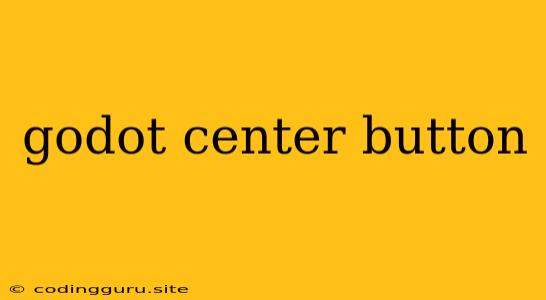Making Buttons Central in Godot: A Guide for Game Developers
Ever wished you could easily center buttons in your Godot game? It's a common task for game developers, especially when designing user interfaces (UI). Luckily, Godot provides several ways to achieve this, each with its own advantages.
Why Center Your Buttons?
Centralizing buttons in your game's UI offers numerous benefits:
- Aesthetic Appeal: Centered buttons create a visually balanced and pleasing look.
- Accessibility: It makes buttons easier to find and interact with, especially for users with different screen sizes or visual impairments.
- Consistency: Maintaining consistent button placement throughout your game provides a user-friendly and predictable experience.
Method 1: Using Anchor Points
Godot's anchor points system offers a powerful way to control the position and size of UI elements, including buttons. Here's how to center a button using anchors:
- Create a Button: Begin by creating a button node in your scene.
- Set Anchors: Navigate to the button's "Node" tab in the Inspector panel. Within the "Anchors" section, select "Center" for both "Left" and "Right", as well as "Top" and "Bottom."
- Adjust Margin: Modify the "Margin" values for the button to fine-tune its size and position.
Method 2: Leverage "Margin" Properties
The "Margin" properties of a button provide a more direct approach to centering. This method involves manually setting the margins to ensure the button is positioned in the center of its parent container:
-
Access Margin: Select the button in your scene and locate the "Margin" properties in the Inspector panel.
-
Centering Calculation: The margin values will be based on the dimensions of the parent container and the button itself. You can use the following formula to calculate the margins for centering:
Margin_Left = (Parent_Width - Button_Width) / 2 Margin_Top = (Parent_Height - Button_Height) / 2 -
Set Margins: Apply the calculated margin values to the respective properties.
Method 3: Employing "Rect" Node
Another technique is to use a "Rect" node as a container for your button. This approach offers greater flexibility and control:
- Create a Rect Node: Add a "Rect" node to your scene as the parent of the button.
- Adjust Rect Node Properties: In the "Rect" node's Inspector panel, set its "Size Flags" to "Expand" or "Expand and Shrink."
- Position Button: Within the Rect node, set the button's position using the "Margin" properties.
- Center Within Rect: Now, as the "Rect" node resizes, the button will stay centered within the container.
Method 4: Using Code for Dynamic Centering
For situations where you require dynamic button positioning based on gameplay events or user interactions, consider utilizing code:
- Script the Button: Attach a script to your button.
- Retrieve Parent Size: Obtain the dimensions of the button's parent container using the
get_size()method. - Calculate Center: Calculate the button's center position based on the parent's size and the button's own size.
- Set Button Position: Update the button's position using the
set_pos()method, applying the calculated center coordinates.
Example Code for Dynamic Centering:
extends Button
func _ready():
var parent_size = get_parent().get_size()
var button_size = get_size()
var center_x = (parent_size.x - button_size.x) / 2
var center_y = (parent_size.y - button_size.y) / 2
set_pos(Vector2(center_x, center_y))
Important Notes:
- Parent Container: Ensure that your button's parent node is properly sized. If the parent has no defined size, the button might not be centered correctly.
- Layout System: For more complex UI arrangements, consider using Godot's built-in layout containers, such as "HBoxContainer", "VBoxContainer", or "GridContainer," which provide automatic layout management.
Conclusion
Centering buttons in Godot is a fundamental UI design element. Understanding the different methods available allows you to choose the approach that best suits your project's requirements. From anchor points and margins to code-driven dynamic centering, you can create visually appealing and user-friendly interfaces that enhance the overall gameplay experience.
